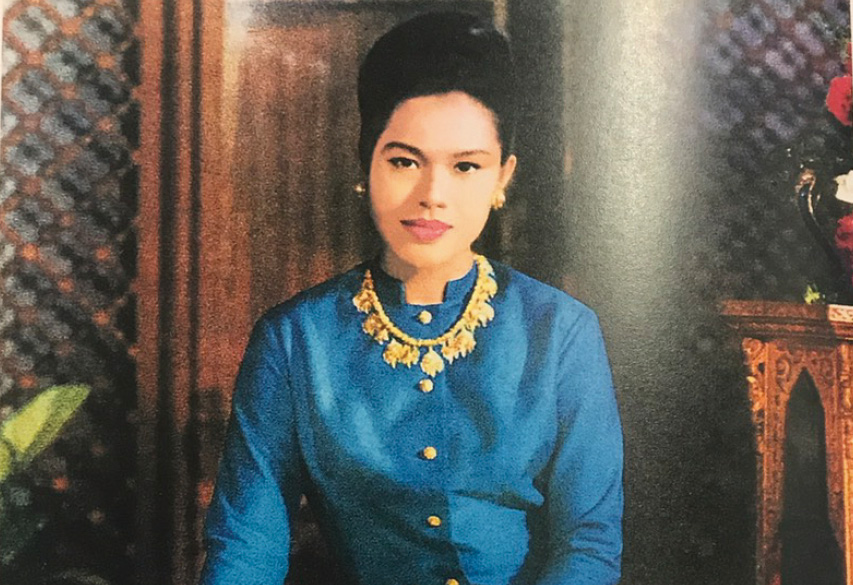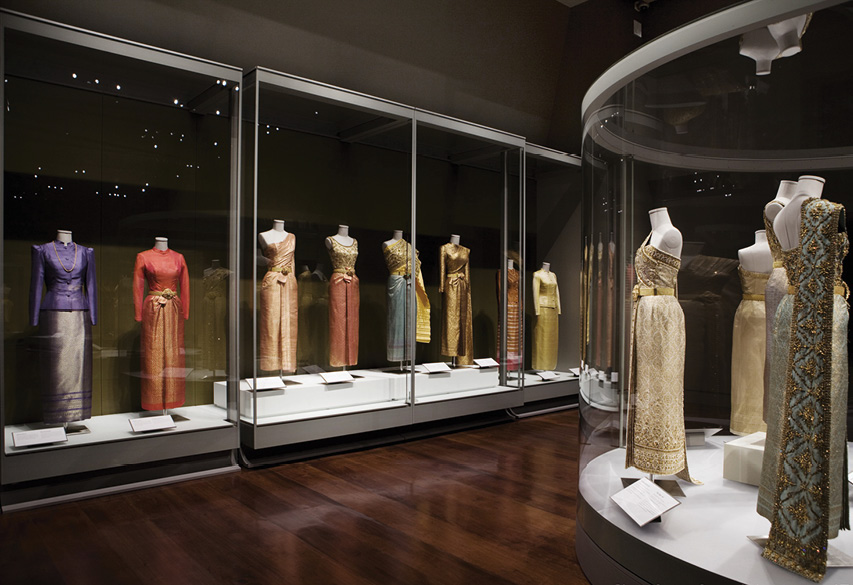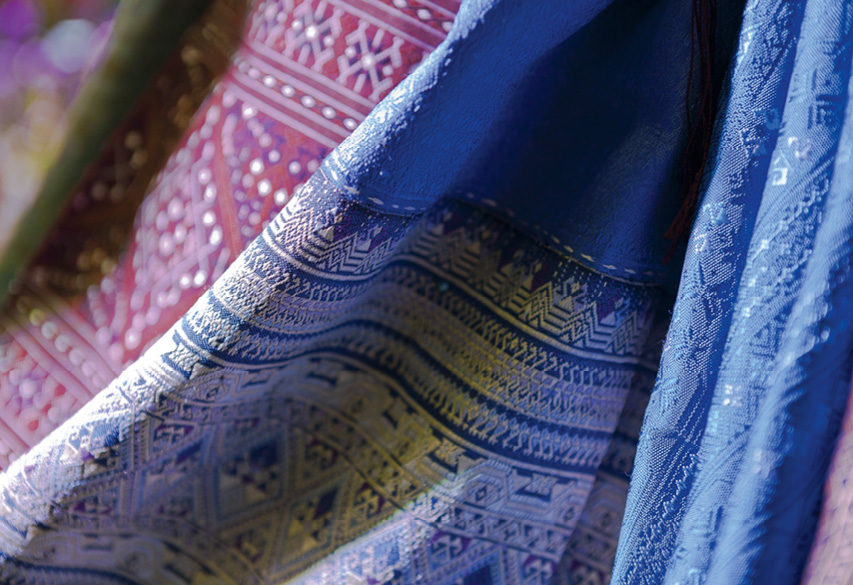In August of 2017, Bangkok’s leading fashion designers descended on Chiang Mai, Thailand’s northern capital, for an exhibition that put the spotlight on Thai textiles in all their glorious forms.
With the Royal Park Rajapreuk as the backdrop, the cream of Southeast Asian fashion circles gathered for The Magic of Thai Fabric, a glamorous evening of fashion shows, schmoozing and canapes. Here, designers—some internationally famous, others up-and-coming fresh faces from the latest Bangkok Fashion Week—transformed five traditional Thai fabrics into collections that looked like they could have walked straight off the runways of Milan.
Queen Sirikit
The timing could not have been better. Held in the birth month of Her Majesty Queen Sirikit, The Magic of Thai Fabric paid tribute to the queen’s liflong devotion to her nation’s handicraft past. In Bangkok, the Queen Sirikit Museum of Textiles stands as tribute to her personal devotion to the fabrics of Thailand, from richly embroidered silks to regal brocade and hilltribe ikat dye-work. Meanwhile, across the country, Her Majesty’s SUPPORT foundations, established in 1976 as resource centers on handicraft skills, continue to pass down the essential, age-old knowledge of Thai fabric-making to new generations.
“The queen’s love and support for local, handmade Thai fabrics is well known” explains Disaya Sorakraikitikul, one of the five designers who curated The Magic of Thai Fabric exhibition. “For this show, we took inspiration from all that Her Majesty has done in order to honor her.”
The Bangkok-born head designer of fashion house Disaya is an international sensation thanks to her feminine prints and ready-to-wear collections, as worn by Hollywood actresses including Anne Hathaway and January Jones. But these days, the 39-year-old protege of John Galliano is rediscovering her home nation’s extraordinary homegrown fabric culture.
“The idea of using Thai fabric in contemporary design is something that I hadn’t really experimented with until the Tourism Authority of Thailand contacted me about the show,” says Disaya, in reference to The Magic of Thai Fabric’s organizers. “We had to do a lot of research, making ourselves familiar with the fabric before anything else.”
As the latest collections of the spring/summer 2017 season attest, Disaya is not alone in supporting Thai fabrics. More and more Bangkok-based labels are embracing the country’s rich textile craft culture, and placing natural, Thai-made linens, cottons and silks at the core of their work. You can see it in the elegant eveningwear of Atelier Pichita, the youthful, minimal designs of Vick’s Weekend, the trending fabric-driven basics of W’menswear, and the break-through seasonal collections of Seeker x Retriever.
You can see it in the elegant eveningwear of Atelier Pichita, the youthful, minimal designs of Vick’s Weekend, the trending fabric-driven basics of W’menswear, and the break-through seasonal collections of Seeker x Retriever.
Kanapot Aunsorn, the youngest among the designers who joined The Magic of Thai Fabric, is part of a new generation of creative fashion minds who are drawn to their local heritage in order to create clothes worthy of international catwalks.
“I try to use Thai fabric as much as I can in every collection,” says the rising designer. “For my collection shown at Elle Fashion Week 2017, The Future is Now, for example, I ordered a custom-made madmee [a Thai silk woven into intricate patterns] in star patterns and turned it to dresses and skirts.”
Queen Sirikit Museum of Textiles
Kanapot has been integrating Thai fabrics into his collections since his debut at Srinakharinwirot University’s thesis collection show, Fash, which experimented with Thai silks applied to military inspired items. To celebrate Her Majesty’s support of textiles in Chiang Mai, however, Kanapot worked with indigo fabric from Sakon Nakhon province, taking the rich blue look of Thai indigo and turning it into streetwear with refined attitude.
“There’s no such thing as ordinary streetwear in my personal fashion glossary,” explain the designer. “Indigo streetwear for my brand is more like street couture. I personally define the style as everyday outfits twisted with a touch of grandeur and extraordinary patterns. My show even featured an indigo-wrapped skateboard.”
As a Thai-born fashion designer, Kanapot said he has always taken inspiration from Queen Sirikit’s style and work to promote craftsmanship of local fabrics. “I was such a great honor to get involved in this project,” he says. “This has been one of the greatest achievements of my life as a designer.”
He sees it as every Thai designers’ duty to continue Queen Sirikit’s willingness to promote Thai fabrics. “At least every Thai designer should try experimenting with local fabric,” he explaines. “Designers are trendsetters. We have the power to bring local fabric into the spotlight.”
For the local producers of Thailand’s fabrics, initiatives like this are essential for spreading the word of the value of their products. Chayapa Thongying owns Nang Noi Phaa Yom Kraam, the production facility that made the indigo dye fabrics (called kraam in Thai) for Kanapot’s show, and was present when they went down the catwalk.
“We are beyond happy and excited that our fabric was chosen to be a part of this show by such a modern and professional designer,” says Chayapa, whose indigo business supports various generations of a community in Sakon Nakhon province. We as a whole community are grateful for this show,” she says, “and want to keeps conserving and developing our fabric so that it becomes known and recognized not just nationally but internationally.”
This lofty ambition might not be far from reality. International fashion houses of the finest pedigree have recently shown a love for traditional Thai design, from the northern Thai tribe jackets of Isabel Marant’s spring/summer 2016 show to the sarong-wrapped skirts that Dries Van Noten showed in 2010’s spring/summer show, to the tassel, cross-body bags of Tory Burch’s spring/summer 2013 collection.
As the crowd dispersed from The Magic of Thai Fabric and the spotlights were put away, the Tourism Authority of Thailand had well and truly driven home its message about the versatility and modern flair that, in the right designer’s hands, can be drawn from traditional Thai fabric craft. The fashion world can be thankful that, thanks to Her Majesty Queen Sirikit’s foresight, such stunning handicrafts still remain.
Essentials
Atelier Pichita
Disaya
2/F, Central World, Rama I Rd., 02-646-1828. Open daily 10am-10pm.
www.disaya.com
Seeker x Retriever
Queen Sirikit Musuem of Textiles
Vick’s Weekend
1/5 Phahon Yothin 7 Alley, 02-331-3196.
W’menswear


